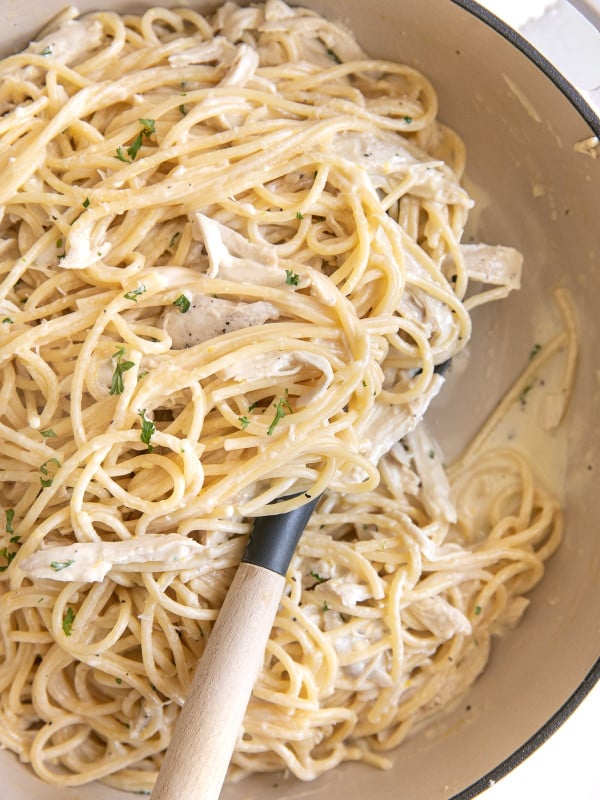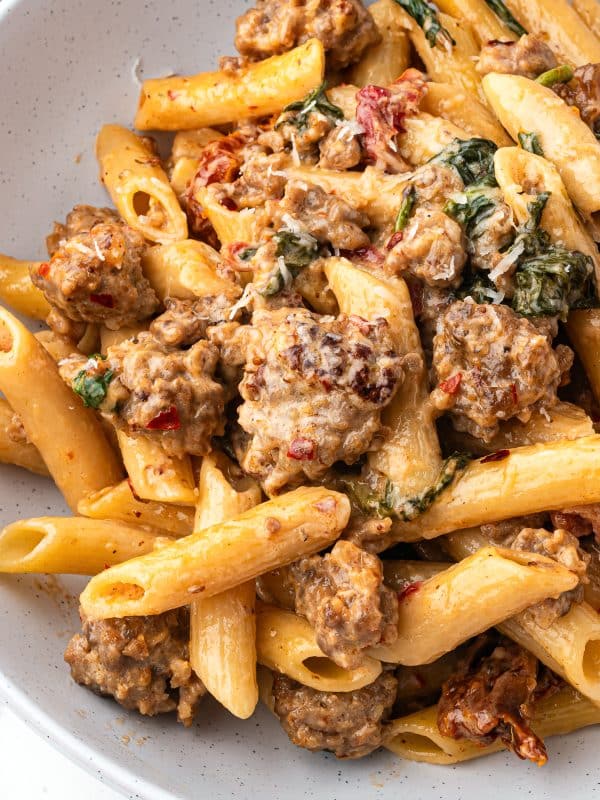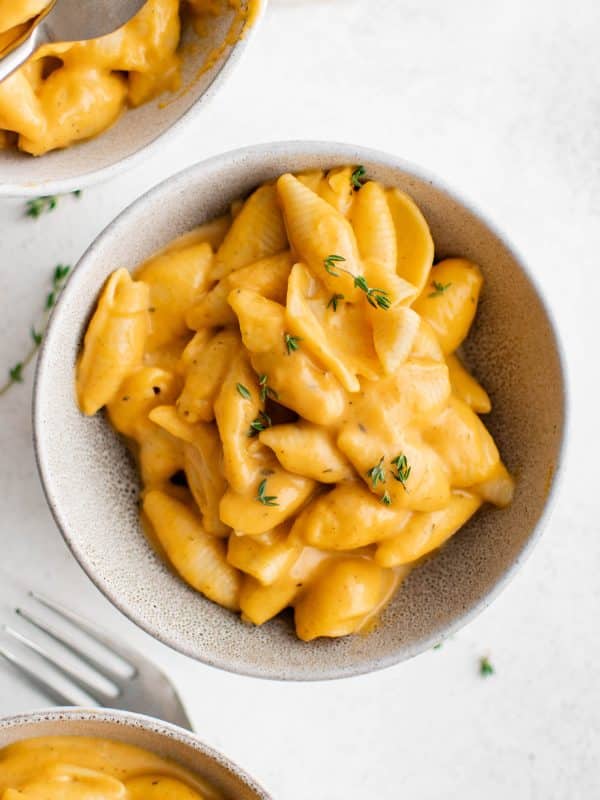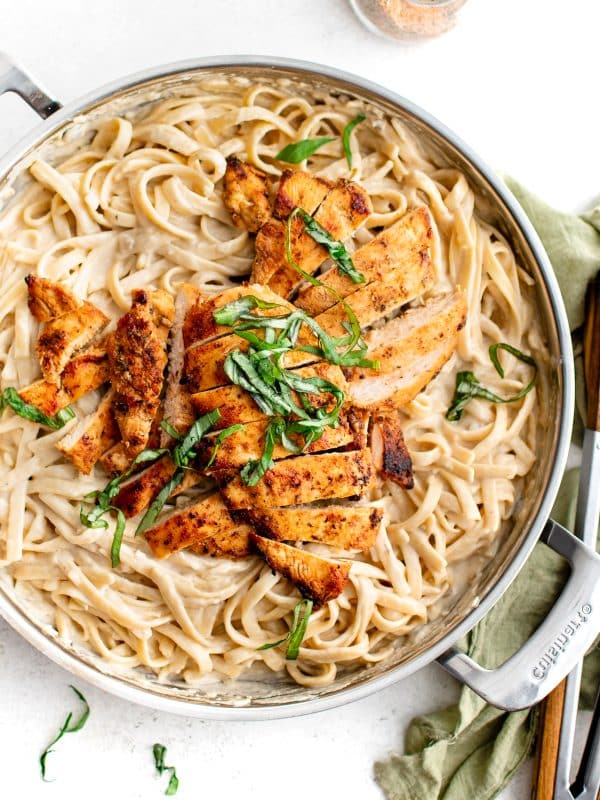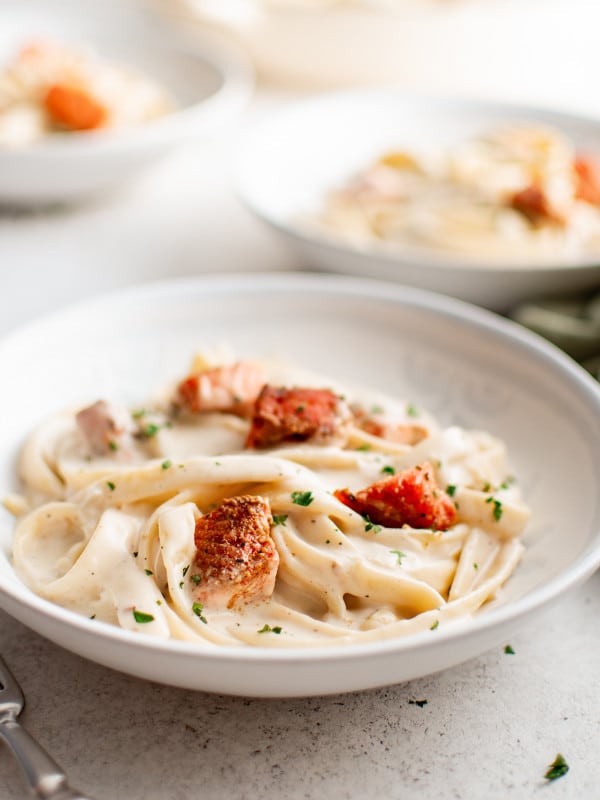This post may contain affiliate links. See my disclosure policy.
This Cajun Chicken Alfredo is a comforting pasta dish filled with flavorful seasoned chicken and pasta tossed in a rich and creamy, Cajun-spiced Alfredo sauce. So easy to make and a delicious alternative to classic Alfredo sauce.

Creamy Cajun Chicken Pasta
I’ve shared so many delicious pasta recipes on this website, but this Cajun chicken Alfredo is BY FAR one of my favorites. A Southern-inspired twist on classic fettuccine Alfredo, it’s loaded with bold and spicy blackened chicken, crispy bacon, and a creamy Cajun-spiced Alfredo sauce. It’s similar to my blackened chicken Alfredo, but it packs even more bold and spicy Cajun flavor into every delicious bite.
Rich, indulgent, and way easier to make at home than you’re probably thinking, it’s the perfect weeknight dinner upgrade and it’s ready in under 45 minutes!
Why This Recipe Works
Big flavor, minimal effort: The combination of crispy bacon, Cajun spices, and creamy Alfredo sauce comes together quickly, but tastes like you spend hours in the kitchen. It’s WAY better than anything you’ll get from even your favorite restaurant.
Customizable: This is actually my favorite part about this recipe. You control the overall heat and salt level by adding more or less Cajun seasoning to suit your preference. You can even swap Cajun seasoning for homemade Creole seasoning or blackened seasoning for a milder version.
It’s made with simple ingredients: All of the ingredients in this Cajun chicken Alfredo should be available at most grocery stores. If you can’t find Cajun seasoning, no worries! It’s super easy to make with everyday herbs and spices you probably already have in your spice drawer.
Key Ingredients and Substitutions
Find the printable recipe with measurements in the recipe card below.
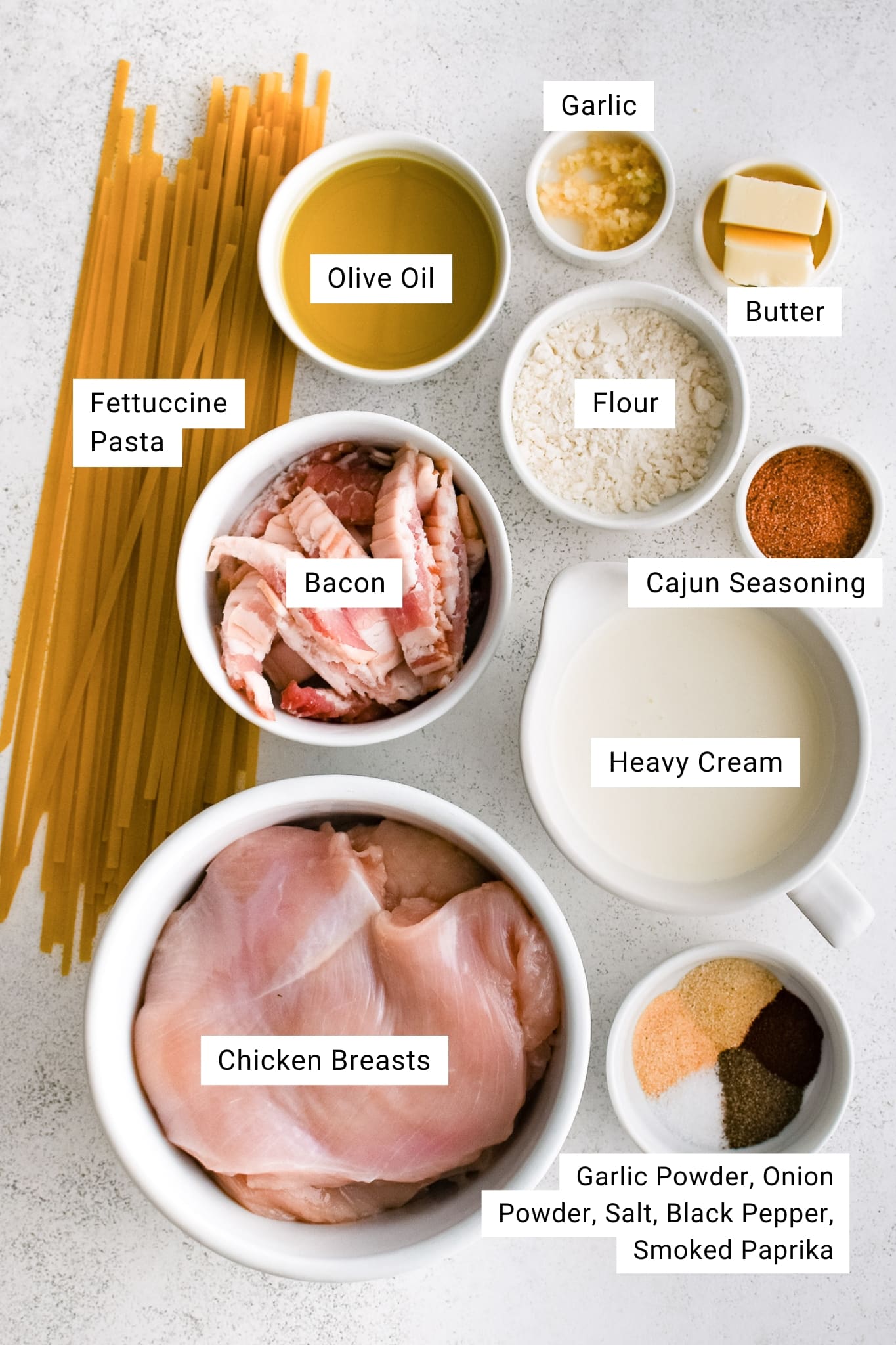
- Bacon: The bacon adds a salty, smoky flavor. Delicious alternatives include spicy andouille sausage or pancetta. For a shortcut, try my Air Fryer bacon or oven-baked bacon.
- Chicken: For this recipe, we’re pounding chicken breasts to 1/2-inch thickness and seared them in a large skillet. You can also slice each boneless skinless chicken breast in half to make two thinly sliced chicken cutlets, or swap chicken breasts for chicken thighs. You can even swap the chicken for an entirely different protein like salmon, blackened shrimp, or spicy Cajun shrimp.
- Seasonings: The chicken is seasoned with a combination of garlic powder, onion powder, salt, black pepper, and smoked paprika. Feel free to substitute this homemade seasoning blend with one (heaping) tablespoon of Cajun seasoning, Creole seasoning, or even blackened seasoning.
- Cajun Seasoning: I highly recommend making your own Cajun seasoning blend. Store-bought blends are convenient, but they’re often packed with salt and varying amounts of cayenne pepper. To make homemade Cajun seasoning you’ll need: Smoked paprika, garlic powder, onion powder, dried thyme, salt, black pepper, and cayenne pepper (for heat). I’ve included a small-batch recipe in the recipe card below.
- Butter + All-purpose flour: Melted butter and flour combine to make a roux. The roux helps thicken the sauce. If you prefer a thinner sauce, omit the flour.
- Heavy cream: I love using heavy cream, but if it tastes and feels too rich, feel free to make this dish with half and half. Half and half is equal parts milk and heavy cream. I do not recommend making Alfredo sauce with whole milk, 2% milk, or plant-based alternatives.
- Pasta water: Starchy, salted pasta water is liquid magic when it comes to cream-based sauces. It helps loosen up the pasta if the sauce becomes too thick or the noodles dry out. Be sure to save at least 2-3 cups before draining the pasta.
- Parmesan Cheese (not pictured above): Be sure to use freshly blended or grated Parmesan cheese. Pre-shredded bags contain additives which result in a lumpy sauce.
Step by Step Instructions
Perfect for busy weeknights or weekend entertaining, this flavorful Cajun chicken pasta recipe is easy to make. Be sure to check out all my tips in the section below!
Before you start cooking, prep the ingredients. This includes pounding the chicken breasts to 1/2-inch thickness or slicing each chicken breast in half to make two thinner chicken cutlets. Pat the chicken dry and let it come to room temperature.
Next, chop the bacon into small pieces, peel and mince the garlic, combine the seasonings, and remove the heavy cream from the refrigerator.

- Season the chicken generously with a combination of garlic powder, onion powder, salt, back pepper, and smoked paprika.

- Then, fry the bacon in a large cast iron skillet until cooked and crisp. Remove the bacon to a clean plate and set aside.

- Bring a large pot of well salted water to a boil. Start cooking the pasta after you flip the chicken (see next step). Cook the pasta until it is al dente.
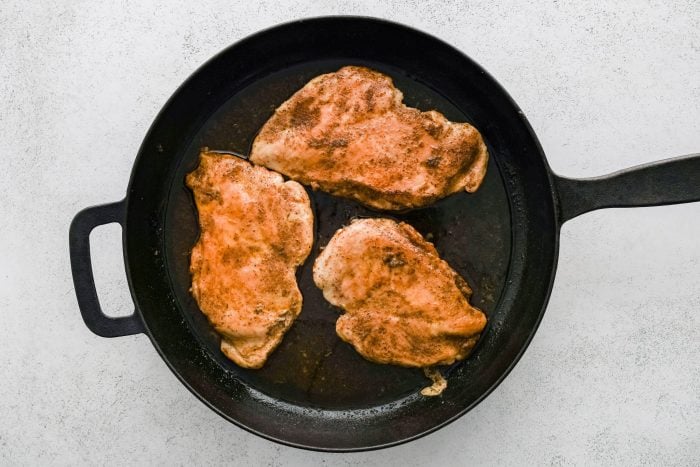
- Return the skillet to high heat. Once the pan is hot, add the chicken and cook for 4-5 minutes on each side. Do not crowd the skillet. If necessary cook the chicken in two batches. Remove the chicken and set aside.

- Melt the butter in the same skillet set over medium heat. Sauté the garlic for 30 seconds, then whisk in the flour, Cajun seasoning, and salt (if using).
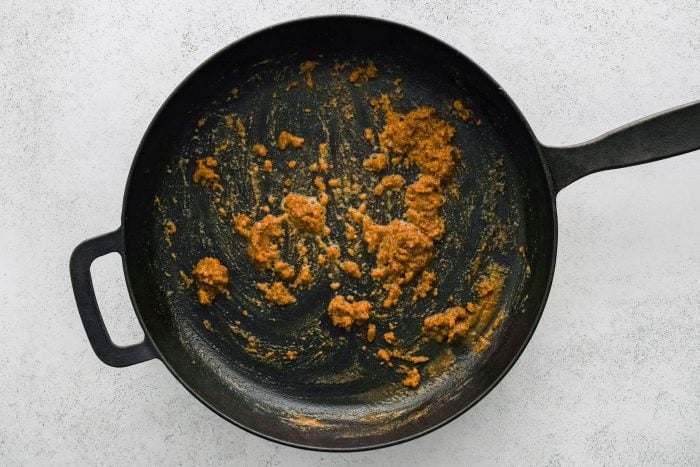
- Whisk continuously for about a minute or so to make a thick roux.

- Still whisking, slowly add the room temperature heavy cream. Continue whisking until fully incorporated and the sauce starts to simmer gently.
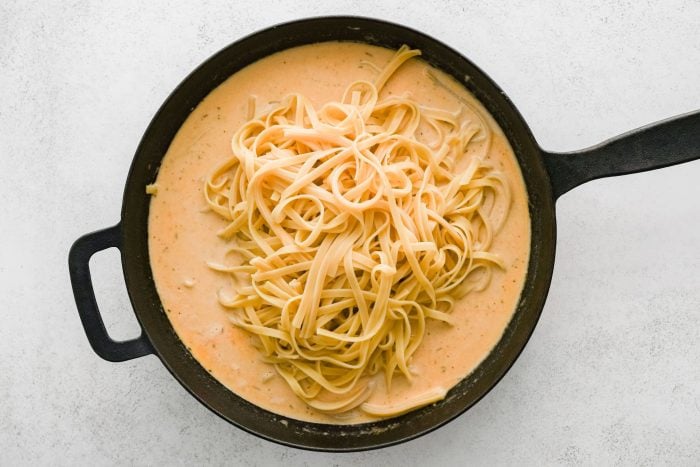
- Reduce the heat to low and simmer for about 5 minutes, or until slightly thickened. Then add the cooked pasta.
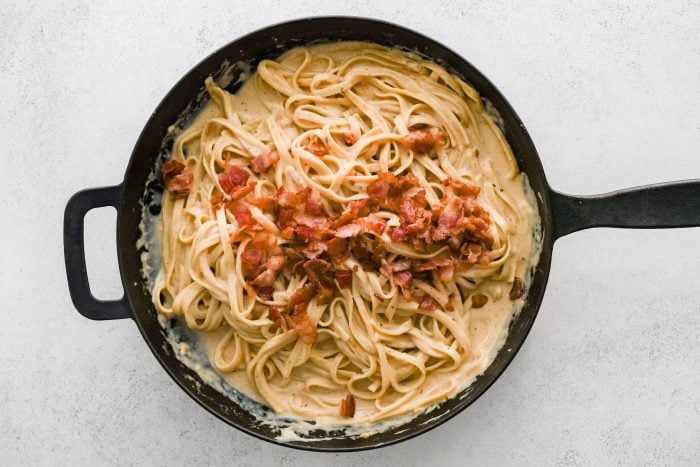
- Gently combine the cooked pasta and bacon with the creamy Cajun Alfredo sauce, then stir in the grated Parmesan cheese. If the sauce is too thick, thin with a splash or two of reserved pasta water.
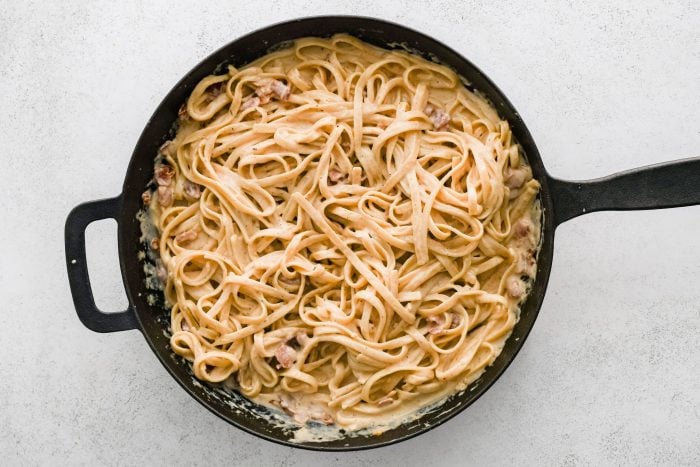
- This pasta is best served immediately. Top with sliced blackened chicken and freshly sliced green onions, if desired.
Cajun Chicken Alfredo REcipe
Cooking Tips
For more in-depth information, be sure to check out the following recipe posts: Blackened Chicken Recipe and Homemade Alfredo Sauce Recipe.
- If you’re using store-bought seasoning hold off on adding any adding salt until the very end of cooking. Store-bought blends are super salty!
- Cajun seasoning can be swapped for blackened seasoning or Creole seasoning. For complete control over the flavor of your dish, I recommend making your own homemade seasoning blends. In general, Cajun seasoning is the most spicy, Creole seasoning is the most savory and herbaceous, and blackening seasoning is a perfect mix of the two. I have homemade recipes for all three. Try them out and see which one you like best!
- Allow your chicken to reach room temperature before cooking. It will cook faster and more evenly.
- Remove the heavy cream from the refrigerator just before you start cooking the bacon. Room temperature dairy is less likely to split or curdle when added to a hot pan.
- Cook the pasta until it is al dente (cooked but still firm to the bite). The pasta will continue to cook in the sauce.
- Reserve at least 2-3 cups of pasta cooking water. It’s great for thinning and emulsifying the sauce, and reviving leftover pasta the next day.

Serving Ideas
We often enjoy this Cajun chicken pasta as a meal on its own, but if you’re looking for something to serve on the side, you have plenty of options.
My absolute favorite side is sweet cornbread, but you can also pair it with a vegetable side dish, such as sautéed zucchini, air fryer Brussels sprouts, or roasted asparagus. It’s also delicious delicious with any of these simple salad recipes:
Optional Veggie Addition
Love veggies? Let’s add some!
There are several ways to include veggies into this recipe: peas, broccoli, carrots, etc. But my favorite is onion, celery, and green bell pepper. This flavorful trio, known as the Holy Trinity of Cajun Cooking, is an essential flavor base in countless Cajun recipes like jambalaya, gumbo, Cajun pastalaya, and étouffée. For this recipe, finely dice one onion, one green bell pepper, and 2 ribs of celery. Soften in butter low and slow before adding the minced garlic. Once softened, continue with the recipe as outline.
Storage Tips
Cajun chicken Alfredo is best served immediately. If you have any leftovers, place them in an airtight container in the refrigerator for up to 2-3 days. Freezing is not recommended.
Reheat leftovers in a skillet over medium-low heat. Add a splash of milk, cream, or reserved pasta water to loosen the sauce.
More Creamy Pasta Recipes
If you make this Cajun chicken Alfredo recipe, I’d love to hear how it turned out in the comment section below! Your review will help other readers in the community. And if you’re hungry for more delicious food inspiration and exclusive content, join my free newsletter here.

Cajun Chicken Alfredo Recipe
Ingredients
- 1 pound chicken breasts, (2-3 pieces), pounded to about 1/2-inch thickness with a meat mallet
- 1 teaspoon smoked paprika
- 1 teaspoon garlic powder
- 1 teaspoon onion powder
- ½ teaspoon salt
- ½ teaspoon black pepper
- 6 slices bacon, sliced
- 10 ounces fettuccine pasta
- 1 tablespoon olive oil
- 2 tablespoon butter
- 4 cloves garlic, minced
- 1 tablespoon all-purpose flour, optional
- 1 tablespoon Cajun seasoning
- 1½ cups heavy cream, brought to room temperature
- ½ cup Parmesan cheese, fresh grated
- salt, to taste
Instructions
- Remove the chicken from the refrigerator and pound to equal thickness (about 1/2-inch) or slice each chicken breast in half to make two thinly sliced chicken cutlets. Pat the chicken dry with paper towels and then season both sides with garlic powder, onion powder, salt, black pepper, and paprika. Set aside.
- Cook the bacon in a large skillet set over medium heat until crisp, about 5 minutes. Once cooked, remove the bacon from the skillet with a slotted spoon and set aside. Reserve approximately 2 tablespoons of rendered bacon grease in the pan.
- As the bacon cooks, bring a large pot of salted water to a boil. Once boiling, maintain a simmer so that it's ready to cook the pasta when needed.
- Return the skillet to high heat and add the olive oil (to the bacon grease). Once hot, add the chicken and cook for about 4-5 minutes per side or until the internal temperature registers 165 ℉ as measured by a digital meat thermometer. Remove the chicken and set aside.
- Start cooking the pasta just after you've flipped the chicken over. Cook the pasta until al dente (about 2 minutes less than the package instructions). Before draining, set aside at least two cups of boiling pasta water. Then drain and set aside.
- Return the same pan to medium heat. Melt the butter and add the minced garlic. Cook for about 30 seconds, or until fragrant, then whisk in the all-purpose flour and Cajun seasoning. Cook, whisking continuously for about 1 minute.
- Tip: If your skillet has a lot of brown bits stuck to the bottom, add 1-2 tablespoons of reserved pasta water to the skillet and scrape off using a metal spatula. Don't toss the brown bits out! That's all delicious, yummy flavor.
- Slowly add the heavy cream, whisking continuously. Continue whisking until fully incorporated and the sauce starts to gently simmer – about 5 minutes. Reduce the heat to prevent the sauce from boiling.
- Add the pasta and return the bacon to the skillet, turning to coat in the sauce. Sprinkle with the freshly grated parmesan cheese and gently toss to coat. If the sauce is too thick, slowly add reserved pasta water until the desired consistency is reached.
- Serve immediately with sliced green onions if desired.
Notes
- For complete control over the flavor of your dish, I recommend making your own homemade seasoning blends. In general, Cajun seasoning is the most spicy, Creole seasoning is the most savory and herbaceous, and blackening seasoning is a perfect mix of the two. Try them out and see which one you like best!
- Transfer any leftovers to an airtight container and place them in the refrigerator for up to 2-3 days. Freezing is not recommended. If possible, store the sauce, chicken, and noodles separately.
- Optional additions: Peas, cherry tomatoes, sun-dried tomatoes, bell pepper, or spinach.
- 1 teaspoon garlic powder
- 1 teaspoon onion powder
- 1 teaspoon smoked paprika
- ¼ teaspoon cayenne pepper (adjust to taste)
- ¼ teaspoon black pepper
- ¼ teaspoon ground celery salt
- ¼ teaspoon dried thyme
- Pinch of salt, optional, to taste
Nutrition
Nutrition information is automatically calculated, so should only be used as an approximation.




